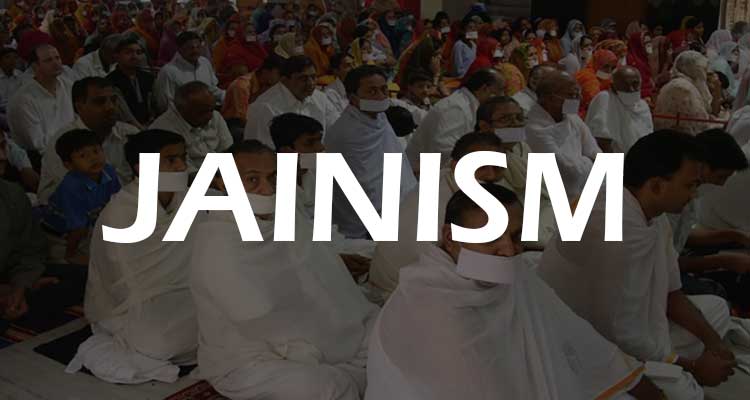The changing features of social and economic life in the 6th century BC were closely linked with the changes in religion and philosophical speculations.
The rise of trading class, the vaishyas, gave a jolt to established hierarchies. Vedic sacrifices were seen as most complicated and time-consuming.
Religious text mostly in Sanskrit, which was the elite language doesn’t attract the normal peoples.
Jainism Origin
The origin of Jainism is still a mystery. But, in Rigvedi hymns there are clear references to Rishabha and Aristanem.Rishabha is known as first tiruthankara. Rishabha was described as incarnation of Narayana in the Vishnu Purana.
The total outcome of Jainism is from the teaching of 24 tiruthankaras. All of the tiruthankaras belongs to kshatriyas clan.
The 23rd tiruthankara named Parsavanatha, seems to left a well formed oraganization behind him. Vardhamana Mahavira family and parents itself Parsavanatha followers.
Vardhamana Mahavira (240-468 BC)
Vardhamana Mahavira was born in 540 BC, in a village called Kundagrama near Vaishali (North Bihar).His Parents were, Siddhartha ( Head of Kshatriya Jantrika )and Trishala (Lichchhavi Princess). Mahavira’s family connected with Magadha.
In the beginning Mahavira was in the normal life. His wife was named as Yasoda and they had a daughther named Anojja.
Enlightenment
In search of truth, Mahavira became as ascetic at the age of 30. After 12 years he attained nirvana or Kaivalya ( Supreme knowledge or Perfect knowledge at Jimbhikagrama on the bank of river Rijupalika under the sal tree.
Through Kaivalaya, Mahavira conquered misery and Happiness. He was acclaimed as 24thtiruthankara. He was also known as Jina (Conqueror).
Mahavira hardly believed in Karma and transmigration of soul.
He rejected the Vedas and Vedic rituals. He didn’t believed in the existence of God.
Mahavira propagated Jainism for 30 years in Kosala, Magadha, Mithila, Champa.
He passed away in the age of 72 in 468 BC.
List of 24 tirthankaras
1 Rishabhanatha (Adinatha) Bull
2 Ajitanatha Elephant
3 Sambhavanatha Horse
4 Abhinandananatha Monkey
5 Sumatinatha Goose
6 Padmaprabha Padma
7 Suparshvanatha Swastika
8 Chandraprabha Crescent Moon
9 Pushpadanta Crocodile or Makara
10 Shitalanatha Shrivatsa
11 Shreyanasanatha Rhinoceros
12 Vasupujya Buffalo
13 Vimalanatha Boar
14 Anantanatha Porcupine according to the Digambara
Falcon according to the Śvētāmbara
15 Dharmanatha Vajra
16 Shantinatha Antelope or deer
17 Kunthunatha Goat
18 Aranatha Nandyavarta or fish
19 Māllīnātha Kalasha
20 Munisuvrata Tortoise
21 Naminatha Blue lotus
22 Neminatha Shankha
23 Parshvanatha Snake
24 Mahavira Lion
Terms Associated with Doctrine of Jainism
Asceticism and Penance
Freeing oneself from cycle of birth and rebirth.
Monastic life
It’s an necessary condition of salvation.
Ahimsa
No harm to the living beings.
Satya
Should always speak truth
Asteya
Non- Stealing, Not to posses anything from others which is not willing to offered.
Brahmacharya
Control over one’s senses and to keep them free.
Aparigraha
To attain detachment from people, places and materials.
Three Gems of Jainism
- Right Faith (Is the belief in what one knows)
- Right Knowledge (Knowledge of the Doctrines of Jainism)
- Right Conduct (includes 5 points)
- Ahimsa (Non- Violence)
- Satya (Truth)
- Asateya (Non- Stealing)
- Aparigraha (Non-possession)
- Brahmacharya (Chasity)
Sections of Jainism
Bhadrabahu, spread Jainism in South India, whereas Sthulabhadra spread Jainism in North India. The Followers of Bhadrabahu were known as Digambaras as they believed in the retention of the rule of nudity.
The followers of Sthulabhadra known as Shvetambaras, as they wore white garments to emphasis Pure and Non- violence
Jain Councils
The First Jain Council was held at Pataliputra, under Sthulabhadra, around 300 BC. Compilation of 12 angas, replacement of last 14 purvas were completed in this council.
The second Jain Council was held at Vallabhi (Gujarat) in 512 AD and was presided by Devaradhi Kshamasramana. The main purpose of this council was to collect the sacred texts and write it systematically.
Spread of Jainism
Jainism was spread through the followers of Mahavira. Jainism gradually spread through the South and West India. Chandragupta Maurya (322-298BC) was the main reason for spreading Jainism in Karnataka.
Jainism also spreads through Gujarat and Rajasthan. (Shvetambaras section prevailed here)
Digambaras were dominant in Mysore (Karnataka).
Decline of Jainism
There are Various factors on Decline of Jainism
- Extreme Ahimsa was the main reason for the Decline. Normal man cannot attain this.
- Avoiding medicines when ill and Plucking of Fruits, Vegetables seems as Sin are some more reasons which doesn’t attract the normal peoples on the Jainism.
- After Bimbisara and Ajastshatru, no king of the later dynasties extended help in spread.
- Finally extreme austerity and penance could not find favour with common people.

